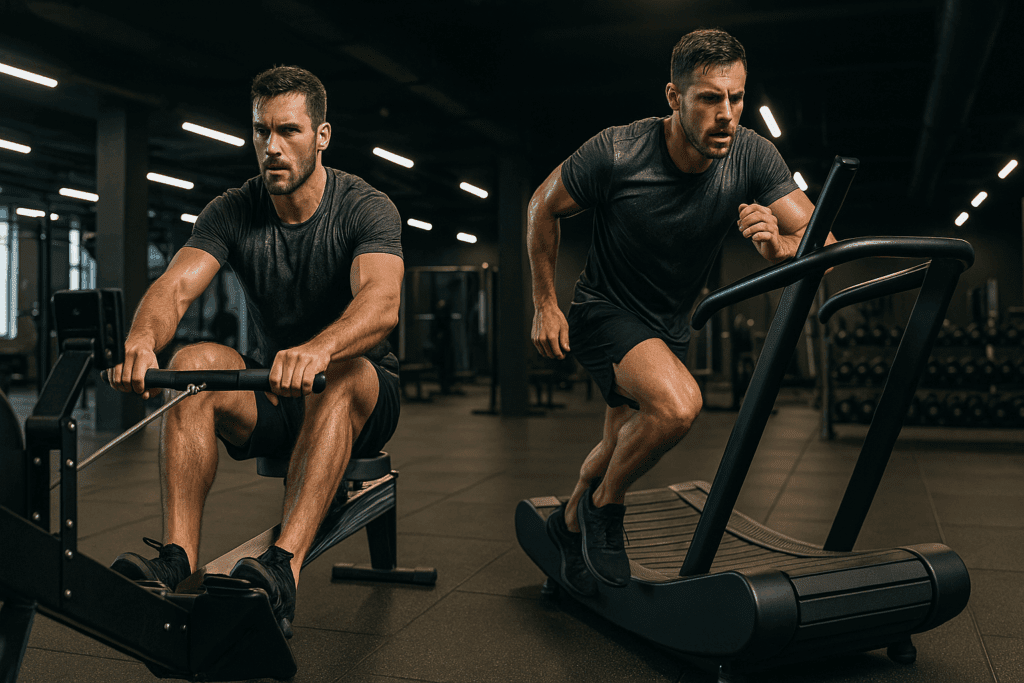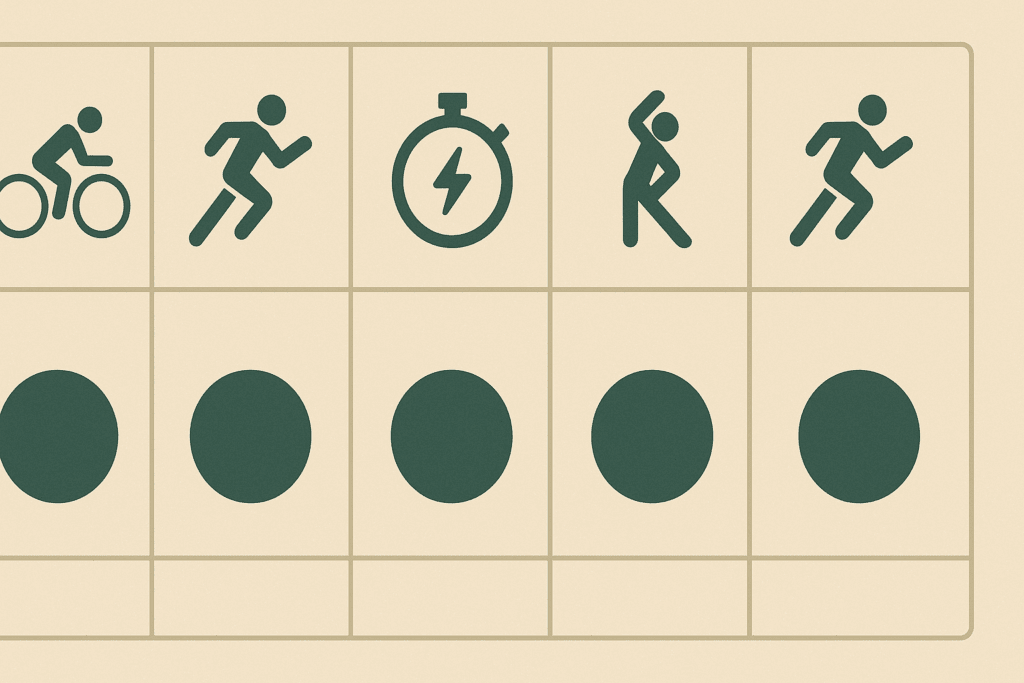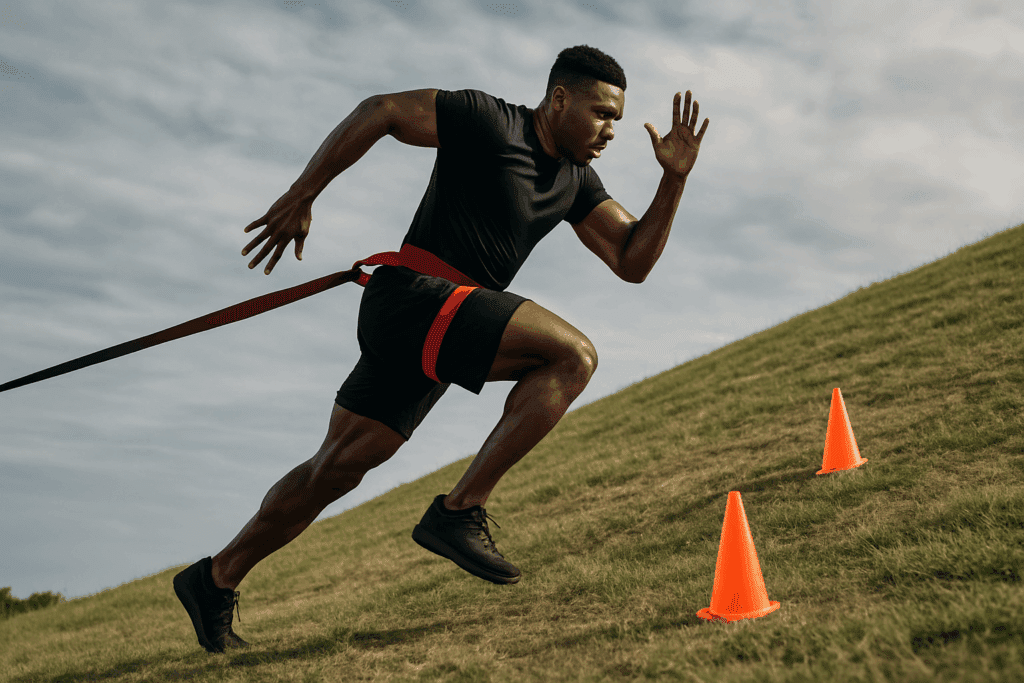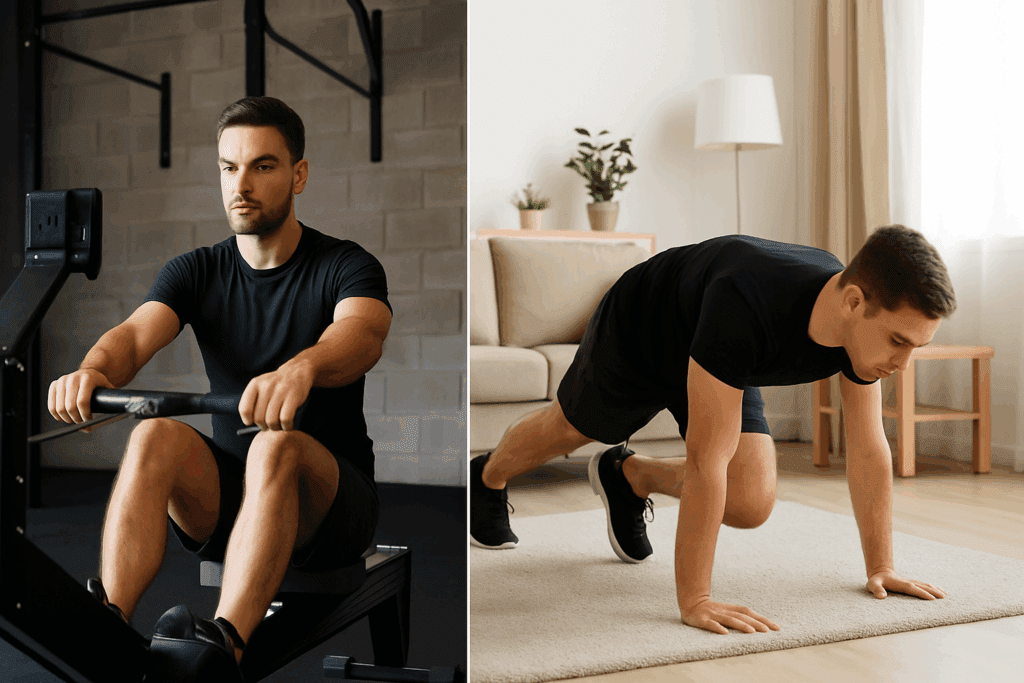Cardiovascular health and endurance are essential pillars of physical fitness, especially for men aiming to improve overall performance, maintain long-term vitality, and cultivate mental resilience. With demanding professional schedules, family responsibilities, and limited time for training, men are increasingly seeking effective, flexible, and results-driven solutions to build stamina and enhance physical performance. Whether you’re training in a fully equipped gym or prefer the convenience of your living room, integrating a structured cardio workout for men into your routine can profoundly impact your health trajectory. This guide explores the best cardio workouts for men, examining evidence-based aerobic strategies, training insights, and adaptable routines that meet the unique needs of today’s busy lifestyle.
You may also like: How to Increase Stamina and Endurance Naturally: Smart Training Tips and Nutrition Habits That Support Cardiovascular Fitness

Why Cardio for Men Matters: The Science of Aerobic Performance and Longevity
Understanding the value of cardio for men requires examining the physiological effects of cardiovascular training on the male body. Cardio workouts for men are not solely about burning calories or weight management; they target the cardiovascular and respiratory systems, increasing the heart’s efficiency in pumping blood and enhancing oxygen delivery to muscles. Over time, consistent aerobic exercise for men reduces resting heart rate, improves blood lipid profiles, and lowers the risk of chronic diseases like hypertension, Type 2 diabetes, and coronary artery disease.
Incorporating good cardio workouts for men into a balanced regimen also boosts mitochondrial density, supporting cellular energy production and muscular endurance. For those pursuing performance enhancement—whether on the field, in the weight room, or during high-intensity sports—these physiological adaptations provide a solid foundation. Enhanced endurance translates to prolonged performance under fatigue, reduced recovery time, and improved mental clarity. Furthermore, emerging research has drawn connections between regular cardiovascular exercise for men and improved cognitive function, highlighting the comprehensive mind-body benefits of staying active.

The Best Cardio Workouts for Men in a Gym Setting
Training in a gym environment offers access to a wide variety of cardio machines, resistance tools, and structured programs that support progressive overload. For those seeking the best cardio workouts for men in a gym setting, high-intensity interval training (HIIT) on a treadmill or rowing machine stands out as a top choice. These workouts alternate between bursts of maximum-effort movement and periods of active recovery, optimizing fat burning and enhancing VO2 max in less time compared to steady-state cardio.
Rowing, in particular, is an often-overlooked cardiovascular exercise for men that activates nearly every major muscle group, including the legs, back, shoulders, and core. A well-executed 20-minute rowing session can provide both aerobic and muscular conditioning, making it a time-efficient option for busy professionals. Stair climbers and elliptical machines also offer low-impact alternatives that reduce joint strain while providing consistent cardiovascular challenges.
For men focused on muscle retention or hypertrophy, integrating light-resistance circuit training with short rest intervals is another gym-based method to build stamina. This hybrid approach combines the benefits of strength training with cardiovascular stress, increasing metabolic demand and enhancing overall physical resilience. The key to optimizing cardio workouts for men in a gym setting is consistency, strategic intensity modulation, and alignment with individual goals.

Cardio at Home for Men: Convenience Without Compromise
At-home fitness routines have gained popularity in recent years, not only due to convenience but also because of the rising demand for accessible, no-equipment options that don’t compromise effectiveness. Cardio at home for men is entirely feasible with a bit of creativity, space, and dedication. From bodyweight circuits to dynamic plyometrics, at-home cardio workouts for men can deliver substantial results when properly structured.
Jump rope workouts, for example, offer a highly portable and efficient form of aerobic training. Just ten minutes of moderate jump rope activity can equal thirty minutes of jogging in terms of cardiovascular impact. Additionally, movements like burpees, mountain climbers, high knees, and jumping jacks provide full-body stimulation and can be programmed into interval-based routines for high metabolic output.
The best indoor cardio workout options for men working from home also include shadowboxing, dance-based cardio, or follow-along HIIT sessions. These methods blend aerobic intensity with rhythm and coordination, making them both physically engaging and mentally stimulating. Crucially, designing cardio workouts at home for guys should involve thoughtful progression—gradually increasing intensity, volume, and complexity to avoid plateaus and injuries.

Structuring a Sustainable Cardio Routine for Endurance and Performance
Creating a long-term strategy for cardiovascular improvement requires more than sporadic workouts. The most effective cardio exercises for men follow a structured progression that aligns with individual capacity, lifestyle, and goals. For men aiming to build endurance and stamina, it is essential to balance frequency, intensity, and recovery.
Training three to five days per week with a mix of steady-state and interval-based cardio allows for both aerobic base development and metabolic conditioning. For example, alternating between 30-minute moderate-intensity cycling sessions and 20-minute HIIT workouts throughout the week promotes cardiovascular efficiency without overstressing the body. Introducing periodization—planned variations in intensity and volume across several weeks—can further enhance outcomes by preventing training plateaus and mental fatigue.
It’s equally important to include mobility and flexibility work to support joint health and postural alignment, which are often compromised with repetitive high-impact movements. Yoga, dynamic stretching, or foam rolling sessions once or twice a week can promote recovery, improve circulation, and prevent injury. When integrated with intention and discipline, a sustainable cardio workout for men becomes not only a method of physical conditioning but also a cornerstone of long-term wellness.
Best Cardio Exercises for Men to Improve Strength and Speed
Cardiovascular training need not be confined to slow, monotonous jogging or repetitive machine work. The best cardio exercises for men seeking improved strength, speed, and performance include explosive and sport-specific movements that challenge coordination, balance, and power output. Sprint intervals, agility ladder drills, sled pushes, and hill sprints exemplify this dynamic approach.
Sprinting, in particular, is an excellent cardiovascular exercise for men that activates fast-twitch muscle fibers, improves anaerobic capacity, and burns fat while preserving lean mass. Short sprints, performed with maximal effort and full recovery, offer a potent blend of speed development and cardiovascular stimulation. Agility drills add a neuromuscular component, improving proprioception and joint stabilization, which are essential for sports performance and injury prevention.
For those interested in functional performance, incorporating compound movements like kettlebell swings or battle rope slams can bridge the gap between cardio and resistance training. These exercises demand full-body coordination and core engagement while maintaining elevated heart rates. When programmed appropriately, they can serve as good cardio workouts for men aiming to optimize both power and endurance.

Mental and Hormonal Benefits of Aerobic Exercise for Men
While the physical advantages of cardio workouts are well-established, the psychological and hormonal benefits are equally profound. Aerobic exercise for men stimulates the release of endorphins and neurotransmitters like serotonin and dopamine, which contribute to mood regulation, stress resilience, and mental clarity. These chemical shifts can be especially impactful for men dealing with occupational stress, burnout, or age-related hormonal changes.
Regular cardiovascular activity also supports healthy testosterone levels by improving insulin sensitivity and reducing excess body fat. Although high volumes of intense endurance training can sometimes suppress testosterone, moderate, consistent cardio routines tend to promote hormonal balance and overall vitality. These hormonal benefits reinforce the notion that cardio workouts are not just about physique; they are deeply connected to emotional and mental well-being.
Additionally, engaging in rhythmic aerobic activity, such as running or cycling, has been shown to facilitate meditative mental states, reducing symptoms of anxiety and depression. For men struggling with cognitive overload or emotional fatigue, incorporating cardio exercises for men into their lifestyle can be a transformative practice. These sessions become not only a time to condition the body but also a space to reset the mind.
The Role of Nutrition and Recovery in Cardio Performance
Optimal performance in cardio training depends not only on the workout itself but also on how the body is fueled and allowed to recover. Men aiming to excel in endurance and stamina training must pay close attention to nutritional quality and timing. Carbohydrates remain a primary fuel source for high-intensity efforts, while proteins support muscle repair and recovery.
Pre-workout meals that combine complex carbohydrates and moderate protein can improve performance, while post-workout nutrition should prioritize muscle glycogen replenishment and tissue repair. Hydration is also critical, as even slight fluid losses can impair cardiovascular efficiency and thermoregulation. Including electrolytes, particularly during prolonged sweat-inducing sessions, can further enhance recovery and prevent cramps or fatigue.
Sleep plays an equally pivotal role. During deep sleep, the body undergoes vital processes of tissue regeneration, hormone regulation, and memory consolidation. Poor sleep disrupts cortisol levels and impairs exercise recovery, making consistent, high-quality rest essential for maximizing the benefits of cardio at home for men and in gym settings alike. Recovery protocols like massage, contrast baths, or even mindfulness practices can further accelerate adaptation and reduce the risk of overtraining.

Customizing Your Routine: Age, Goals, and Fitness Level Matter
Not all cardio is created equal, and the best approach varies depending on a man’s age, current fitness level, and performance objectives. Younger men may benefit from aggressive, high-intensity routines that push speed and metabolic conditioning, while older individuals might prioritize joint-friendly, low-impact modalities such as swimming, cycling, or elliptical training.
Those returning to fitness after a long hiatus should begin with manageable volumes of steady-state work to recondition the heart and lungs before progressing to interval training. Conversely, experienced athletes might incorporate sport-specific conditioning to improve peak output and mimic game scenarios. Customization also involves factoring in time availability, lifestyle, and personal preferences to ensure long-term adherence.
Ultimately, selecting the best cardio for men means choosing methods that are not only effective but also enjoyable and sustainable. Enjoyment plays a crucial role in consistency, and without consistency, even the most advanced program will fall short of its potential. Whether it’s outdoor running, group classes, or cardio workouts at home for guys, alignment between the routine and personal context determines success.
Choosing Between Cardio Machines and Bodyweight Workouts
One of the most common questions among fitness enthusiasts is whether machine-based cardio or bodyweight training is more effective. The truth lies in context and goal alignment. Cardio machines like treadmills, stationary bikes, and rowers offer precise control over intensity, resistance, and time intervals, making them ideal for data-driven progress tracking.
Bodyweight exercises, on the other hand, promote functional strength, coordination, and proprioception. They require minimal equipment and can be performed anywhere, offering flexibility for travel or home-based training. Combining the two modalities can create a comprehensive training experience that covers the spectrum of endurance, mobility, and muscular control.
In practice, integrating both can prevent mental stagnation and physical adaptation. For instance, a weekly routine might include two machine-based interval sessions, one long steady-state outdoor run, and one full-body HIIT workout using bodyweight movements. This diversity challenges the cardiovascular system in multiple ways, stimulating continued progress.
Frequently Asked Questions: Best Cardio Workouts for Men to Boost Stamina and Performance
1. How can I make cardio for men more engaging to avoid workout burnout?
Keeping a cardio routine stimulating often requires blending structure with spontaneity. Incorporating elements of competition—like joining a local challenge or using leaderboard features on apps—can reinvigorate your motivation. Gamified tools such as smart watches and virtual races add a tech-driven twist to traditional aerobic exercise for men, offering real-time feedback and goal-based tracking. Cross-training is another powerful way to keep things fresh; alternating between biking, swimming, boxing, and dance-based formats ensures that no session feels repetitive. The most successful cardio workout for guys is one that fits their lifestyle and adapts with their interests, keeping energy levels high and monotony at bay.
2. What’s the role of breathing techniques in enhancing cardio workouts at home for guys?
Breath control is a frequently overlooked but powerful performance enhancer in cardio at home for men. Implementing rhythmic breathing—where inhalation and exhalation are timed with movement—can improve oxygen efficiency and delay fatigue during sustained cardiovascular effort. Nasal breathing during lower-intensity phases also promotes diaphragmatic activation and reduces cortisol spikes, especially valuable during at home cardio workouts for men focused on stress reduction. Practicing techniques like box breathing between intervals can aid recovery and help recalibrate heart rate variability. Integrating conscious breathwork into a cardio workout for men enhances mental focus, endurance, and long-term aerobic capacity.
3. How do environmental factors influence the effectiveness of cardio exercises for men?
Environmental variables play a subtle but significant role in the performance of cardiovascular exercise for men. Heat and humidity can accelerate fatigue and impact perceived exertion, even if metrics like pace remain the same. Conversely, colder temperatures may delay muscle warm-up, making extended warm-up periods crucial to prevent injury. Altitude changes, even modest ones, can influence oxygen availability, impacting aerobic efficiency. While the best cardio workouts for men are often consistent regardless of setting, understanding and adapting to environmental conditions can optimize both safety and results.
4. Are there any social benefits tied to doing cardio workout for guys in a group setting?
Cardio training in group settings offers more than just accountability—it provides community, support, and a shared sense of purpose. Whether it’s a local running club, a group spin class, or virtual group challenges, the camaraderie can significantly boost adherence and enjoyment. For men who thrive on competition or peer motivation, group cardio exercises for men offer a stimulating environment that fuels performance. Studies also suggest that exercising socially elevates mood-enhancing neurotransmitters more significantly than solo workouts. This can be especially impactful for those integrating a cardio workout for men as part of a broader mental wellness plan.
5. How can I identify the best indoor cardio workout if I live in a small apartment?
Living in tight quarters doesn’t limit your cardio potential. The best indoor cardio workout for small spaces often includes plyometric exercises such as jumping jacks, squat jumps, and mountain climbers, which require minimal space but deliver high intensity. Shadowboxing and resistance band training also allow for dynamic movement without needing bulky equipment. For quieter alternatives that minimize noise and floor impact, consider low-impact dance routines or controlled high-knee marches. What matters most is intentionality; even in a confined space, at home cardio workouts for men can be scaled up with the right combination of volume, tempo, and technique.
6. How do I balance strength training with cardio workouts at home for guys without compromising muscle gains?
The key to maintaining muscle mass while performing cardio workouts at home for guys is to focus on timing, intensity, and fuel. Scheduling cardio on separate days—or performing it post-strength training when glycogen stores are already depleted—can preserve muscular adaptations. Emphasizing moderate-duration, moderate-intensity sessions over long, exhaustive ones reduces the likelihood of catabolic breakdown. Nutritional support, particularly in the form of adequate protein intake and carb cycling, also helps mitigate muscle loss. With thoughtful planning, cardio for men can complement strength routines by enhancing recovery and improving metabolic conditioning.
7. What is the most overlooked factor when selecting good cardio workouts for men?
Individual biomechanics and injury history are often overlooked when designing good cardio workouts for men. For example, a man with tight hip flexors or previous knee injuries may find that rowing or swimming offers a safer and more sustainable path than running or jump-heavy HIIT. Biomechanical alignment affects energy efficiency and injury prevention, particularly during high-rep movements common in cardiovascular exercise for men. Consulting a physiotherapist or fitness coach to assess form and mobility can prevent long-term setbacks. Personalization, more than trend-following, determines the best cardio for men in terms of longevity and performance gains.
8. Are wearable devices useful for tracking progress in cardio workout for men?
Absolutely, wearable tech has evolved into a powerful tool for enhancing cardio workout for men. Devices that track heart rate zones, VO2 max estimations, and recovery scores allow for smarter programming and informed decision-making. Beyond metrics, many devices now offer guided workouts, adaptive feedback, and reminders that help improve consistency. For those engaged in cardio at home for men, wearables can serve as a virtual coach, providing insights that mimic gym-based assessments. When used mindfully, these tools reinforce progress and promote adherence without overwhelming users with data.
9. How does aging impact the effectiveness and safety of cardio exercises for men?
As men age, cardiovascular exercise remains beneficial but requires strategic modifications to ensure safety and effectiveness. Older individuals may experience reduced cardiac output and slower recovery times, necessitating longer warm-ups, lower-intensity intervals, and increased focus on joint mobility. However, regular cardio workout for guys in this demographic can still yield dramatic gains in balance, memory, and metabolic health. Techniques like aquatic aerobics or brisk walking provide joint-friendly alternatives that still raise heart rate and maintain stamina. Aging shifts the focus from maximal output to sustainability, but with adaptation, the best cardio exercises for men can remain part of a lifelong fitness plan.
10. What are emerging trends in cardio workouts at home for guys in the fitness industry?
Cardio workouts at home for guys are being reshaped by innovations in virtual fitness platforms, AI-driven coaching, and interactive equipment. Smart mirrors, virtual reality games, and immersive cycling apps like Zwift or Peloton are redefining what it means to do a cardio workout at home for men. Functional movement screens embedded in apps now provide real-time correction and posture feedback, enhancing both safety and performance. Gamified HIIT sessions and hybrid routines that fuse mindfulness with movement are gaining traction, offering a well-rounded approach to fitness. These advancements illustrate that the best cardio for men is evolving rapidly, merging technology, personalization, and engagement to create next-level home workouts.
Conclusion: Making Cardio a Lifelong Ally for Men’s Performance and Health
The journey toward better stamina, energy, and resilience begins with one decisive step: commitment. The best cardio workouts for men are those that fit seamlessly into their lives, accommodate their evolving goals, and promote consistent, sustainable effort. Whether performed in a gym or through at-home cardio workouts for men, aerobic training offers a comprehensive strategy for enhancing not just physical fitness, but also mental clarity, hormonal balance, and long-term health.
By embracing variety, honoring recovery, and listening to their body’s feedback, men can build cardio routines that serve them across the lifespan. Cardiovascular exercise for men is not a one-size-fits-all prescription, but a customizable toolkit designed to fortify the body and sharpen the mind. The key is to treat cardio not as a temporary fix, but as an integral element of a lifestyle dedicated to performance, endurance, and vitality.
Incorporating the best cardio exercises for men into a balanced training regimen requires intention, strategy, and self-awareness. When executed with discipline and adaptability, cardio becomes far more than a workout; it becomes a foundation for peak living. So whether you’re sprinting on a track, cycling through city streets, or powering through a HIIT session in your living room, you’re doing more than breaking a sweat—you’re investing in a healthier, more powerful future.
Was this article helpful? Don’t let it stop with you. Share it right now with someone who needs to see it—whether it’s a friend, a colleague, or your whole network. And if staying ahead on this topic matters to you, subscribe to this publication for the most up-to-date information. You’ll get the latest insights delivered straight to you—no searching, no missing out.
Further Reading:
7 workouts that can boost your aerobic endurance
20 cardio exercises to do at home with minimal equipment, from beginner to advanced

